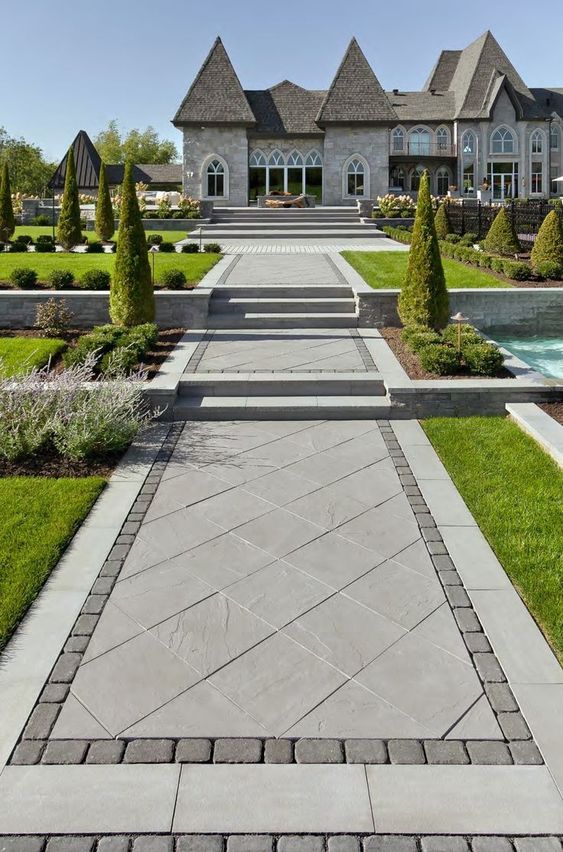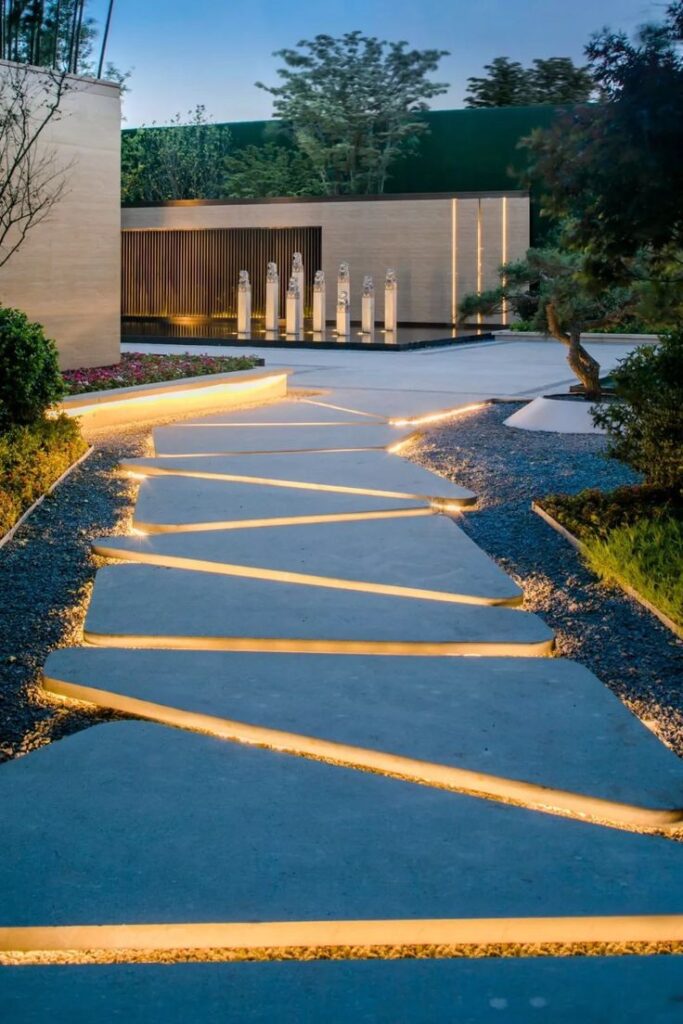Creating captivating outdoor spaces requires careful consideration of hardscape design. This design aspect involves utilizing a variety of elements to enhance the visual appeal and inviting nature of your landscape. Mile High Lifescape‘s blog post aims to introduce you to the fundamental rudiments of hardscape design, providing valuable insights to bring your vision to life. Now, let’s delve into these rudiments in detail.

Choice of accouterments for hardscape design
Accouterments such as bricks, pavers, stones, pebbles, concrete, and other materials form the foundation of hardscape design. Each material carries its unique characteristics, allowing you to create different visual experiences within your hardscape space. Whether you prefer a rustic, modern, or traditional look, the choice of accouterments will play a crucial role in achieving your desired aesthetic.
Outdoor Furniture
Including outdoor furniture in hardscape design creates comfortable and inviting spaces for relaxation, dining, or socializing. Options range from lounge chairs, dining sets, benches, and hammocks to suit different styles and purposes. Consider materials that are weather-resistant and durable, such as teak, aluminum, or synthetic wicker, to withstand outdoor conditions.
Outdoor furniture, when incorporated into hardscape design, enhances the overall ambiance by providing cozy and welcoming areas for leisure, meals, or social gatherings. There is a wide variety of choices available, including lounge chairs, dining sets, benches, and hammocks, catering to different preferences and needs. It is advisable to opt for weather-resistant and long-lasting materials like teak, aluminum, or synthetic wicker, ensuring they can endure the elements.

Lighting Fixtures
Strategic lighting adds ambiance, safety, and functionality to hardscape design. Choose lighting fixtures that complement the overall aesthetic and highlight specific features like pathways, seating areas, or water features. Options include overhead string lights, wall sconces, solar-powered stake lights, and LED spotlights.
Decorative Planters:
Incorporating decorative planters adds a touch of nature and color to hardscape design. Choose planters of various sizes, shapes, and materials that complement the style of the space. Consider seasonal or perennial plants, flowers, or even herbs to create a vibrant and dynamic environment.
Pergolas and Shade Structures
Pergolas and shade structures provide relief from the sun and add architectural interest to outdoor spaces. These accouterments not only offer protection but also serve as a design focal point. Consider materials like wood, aluminum, or vinyl, and customize them with climbing plants, retractable canopies, or curtains for added privacy.
Fire Features
Fire pits, fireplaces, or fire bowls bring warmth, ambiance, and a gathering point to outdoor areas. Whether it’s a traditional wood-burning fire pit or a modern gas-powered fireplace, these features add a cozy and inviting atmosphere for chilly evenings or social gatherings.
Water Features
Water features, such as fountains, ponds, or waterfalls, create a sense of tranquility and serenity in hardscape design. The sound of trickling water adds a soothing element to the outdoor space. Consider the scale, style, and maintenance requirements when choosing the appropriate water feature for your design.
Outdoor Kitchen and Barbecue Area
An outdoor kitchen or barbecue area can be a great addition for those who love outdoor cooking and entertaining. This accouterment includes a built-in grill, countertops, storage cabinets, and a sink. It creates a functional outdoor space for cooking and dining while bringing people together.
Art and Sculptures
Incorporating art pieces, sculptures, or wall hangings adds personality and visual interest to hardscape design. Choose pieces that complement the overall style and theme of the outdoor space. Consider materials that are weather-resistant and suitable for outdoor display.
Outdoor Rugs and Pillows
Outdoor rugs and pillows add comfort, color, and texture to seating areas. They can define spaces, provide a cozy atmosphere, and tie the design elements together. Opt for materials that are weather-resistant and easy to clean.
Privacy Screens
Privacy screens offer seclusion and create intimate spaces within hardscape designs. These can be in the form of trellises, lattices, or vertical gardens. Consider materials that provide both functionality and aesthetic appeal.
Layout structure in hardscape design
Layout structure in hardscape design is an essential aspect to consider when creating outdoor spaces. It involves contemplating the arrangement and amalgamation of different embellishments to form a harmonious and aesthetically appealing composition. By incorporating distinctive structures and features like retaining walls, columns, or elevated planters, you can introduce depth, dimension, and an individualistic flair to your outdoor area.
The layout structure serves as the framework for the overall design, dictating how different hardscape elements interact with each other and the surrounding environment. Here are some key considerations when planning the layout structure:
Functionality and Flow
A well-designed layout ensures that the outdoor space is functional and allows for easy movement and access. Consider how people will navigate through the area and plan pathways and walkways accordingly. Create clear paths that connect different zones and provide logical circulation throughout the space.
Zoning and Segmentation
Divide the outdoor area into distinct zones based on their intended use. This could include areas for dining, lounging, entertaining, or gardening. Each zone should have a clear purpose and be visually separated from others, creating a sense of organization and order.
Focal Points and Centerpieces
Incorporate focal points or centerpieces within the layout structure to draw attention and create visual interest. This could be a water feature, a sculpture, a fire pit, or an architectural element. Place these focal points strategically to anchor the design and create a focal point for the eye.
Proportions and Scale
Consider the proportions and scale of hardscape elements in the overall space. Ensure that structures and features are appropriately sized to create a balanced and proportional composition. Avoid overcrowding or overwhelming the area with oversized elements that may disrupt the visual harmony.
Balance and Symmetry
Achieving balance and symmetry in the layout structure can create a sense of order and visual appeal. Symmetrical designs often feature identical or mirrored elements on either side, while asymmetrical layouts may involve intentional variations for a more dynamic and eclectic look. Choose the approach that aligns with your desired aesthetic.
Integration with Softscape
The layout structure should integrate seamlessly with the softscape elements, such as plants, trees, and shrubs. Consider how the hardscape design interacts with the existing landscape and vegetation. Create a symbiotic relationship between the hardscape, ensuring they complement and enhance each other.
Views and Perspectives
Take advantage of the surrounding views and perspectives when planning the layout structure. Frame desirable vistas or strategically position elements to maximize visual appeal. Consider how the design will be experienced from different angles and viewpoints, both from within the outdoor space and from adjacent areas.
Exterior color palette

Exterior color palette selection is indeed crucial in shaping the overall ambiance of your hardscape design. Colors have the power to influence emotions and create a specific atmosphere in outdoor spaces. Whether you desire a vibrant and energetic setting or a calm and serene environment, choosing the right colors for your accouterments, furniture, and plantings will help create a harmonious and visually striking outdoor area.
Consider the following factors when selecting an exterior color palette for your hardscape design:
- Style and Theme: Determine the style or theme you want to achieve for your outdoor space. Different styles may call for specific color schemes.
- Surrounding Environment: Take into account the natural elements and colors present in the surrounding environment. Consider the colors of existing vegetation, nearby structures, and the overall landscape. Choose colors that harmonize with the surroundings to create a cohesive and integrated design.
- Desired Mood: Think about the mood or atmosphere you want to evoke in your outdoor space. Warm and vibrant colors like reds, oranges, and yellows can create a lively and energetic ambiance, ideal for socializing and entertaining. Cool and soothing colors like blues, greens, and purples can promote relaxation and tranquility.
- Material Considerations: Consider the colors and finishes of the hardscape materials you plan to use, such as stone, pavers, or tiles. These materials may have inherent colors or textures that can influence your color palette choices. Ensure that the colors you select for other elements, such as furniture or plantings, complement and enhance the natural hues of the hardscape materials.
- Coordination and Contrast: Aim for a coordinated color palette that ties together different elements of your hardscape design. Choose colors that work well together and create a sense of unity. Additionally, consider incorporating contrasting colors to add visual interest and make certain elements stand out. Contrast can be achieved through complementary colors (opposite colors on the color wheel) or by using light and dark variations of the same hue.
- Consider Longevity: Keep in mind that color trends may come and go, so it is essential to select colors that will stand the test of time. Opting for classic and timeless colors for foundational elements like walls, paving, or permanent structures can provide a more enduring appeal. You can then introduce trendier colors through easily changeable elements like furniture, cushions, or plantings.
Hardscape lighting

Lighting plays a crucial role in hardscape design, and should not be underestimated. It not only improves the functionality and safety of your outdoor space, but also adds a captivating ambiance. By strategically positioning various lighting options like spotlights, landscape floodlights, or pathway lights, you can draw attention to specific features, emphasize focal points, and extend the usability of your outdoor area well into the night.
Improving Functionality and Safety
Proper lighting is essential for ensuring the functionality and safety of your outdoor space, especially during nighttime hours. By illuminating pathways, stairs, and gathering areas, you create a well-lit environment that guides guests and minimizes the risk of accidents. Ensure key areas, such as seating areas or cooking spaces, are adequately lit for ease of use and peace of mind.
Creating a Captivating Ambiance
Beyond functionality, hardscape lighting adds an enchanting ambiance to your outdoor area. With the right lighting choices, you can set the mood and create different atmospheres for various occasions. Warm, soft lighting can establish a cozy and intimate setting, ideal for relaxed gatherings or romantic evenings. On the other hand, brighter and more dynamic lighting can energize the space for livelier social interactions.
Emphasizing Focal Points and Features
The strategic placement of hardscape lighting allows you to draw attention to specific features and emphasize focal points in your outdoor design. Utilize spotlights to highlight architectural elements, sculptures, or unique landscaping features, creating visual interest and adding depth to your hardscape design. Accent lighting can be employed to showcase ornamental trees, water features, or other focal points, making them stand out in the nighttime landscape.
Extending Usability Beyond Daylight Hours
By incorporating hardscape lighting, you can extend the usability and enjoyment of your outdoor area well into the night. Properly illuminated seating areas, dining spaces, or entertainment zones create an inviting atmosphere for social gatherings, allowing you and your guests to make the most of your outdoor space after dark. Whether it’s a cozy dinner or a lively party, hardscape lighting ensures your outdoor area remains functional, safe, and visually appealing.
Conclude
By incorporating these fundamental rudiments into your hardscape design, you can elevate the aesthetics and functionality of your outdoor space. Whether you’re looking to create a cozy patio, a stunning garden walkway, or a captivating backyard retreat, the team at Mile High Lifescape is here to help you bring your hardscape vision to life. Contact us today and let’s transform your outdoor space into a truly remarkable and inviting environment.
Learn more: https://milehighlifescape.com/blog/hardscape/8-hardscape-elements-youll-love/